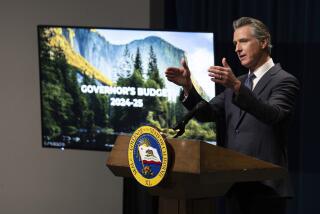EDD answers only 10% to 17% of calls from jobless, records show
SACRAMENTO — Four months after a botched computer upgrade delayed unemployment benefits for tens of thousands of Californians, jobless workers are still finding it nearly impossible to reach state employees for help.
On any given day in recent months, as many as 90% of callers to the Employment Development Department seeking information about missed payments or unprocessed claims failed to reach a live worker, according to agency phone records obtained by The Times.
Callers who don’t get through to staff are routed to a recorded voice directing them to seek answers on the EDD website or get help through an automated self-service phone number — options that many unemployed workers have already tried in vain.
The maddening cycle has frustrated jobless workers such as Robert Rowe, a laid-off aerospace worker from Westlake Village who says his financial situation is deteriorating fast. He’s behind on his mortgage and his car payments and is having trouble paying for insulin to treat his diabetes.
“I’m overdue on every bill I have due to the negligence or incompetence” of the EDD, said Rowe, 55, whose $450-a-week payments mysteriously stopped in December. “I haven’t been able to get through to anyone. It’s a chase-the-tail-in-a-circle thing.”
The near-collapse of customer service is just the latest headache for the EDD, which has been struggling with the fallout from a disastrous launch of an upgraded computer system over Labor Day weekend. A software glitch delayed payments to about 150,000 Californians, forcing the agency to revert to processing some claims by hand.
To speed that effort, EDD redeployed employees from its phone lines to assist with claims processing — creating a shortage of customer service workers just as demand was soaring. That worsened a system that was already hobbled by a decision in May to answer calls only from 8 a.m. to noon so it could assign customer service workers to other duties in the afternoons.
Agency phone records show that over the three-month period from Oct. 6 to Jan. 4, the EDD received an average of 3.9 million calls a week. From 83% to 90% of those calls went unanswered on any given day, according to the records. Some callers lucky enough to get through had to dial more than 40 times to reach an agent.
EDD spokeswoman Loree Levy said deep budget cuts have hindered the agency’s ability to staff its phones. The federal government pays the bulk of the state’s cost to administer the unemployment insurance program, but the sequester and other belt-tightening have reduced those funds substantially.
Levy said the EDD’s total staffing has dropped to 2,500 employees at the end of November from a high of 3,800 during the recession. Three hundred positions were lost in just the last three months, Levy said.
“We are not happy about the limited phone service we offer our unemployment insurance customers,” Levy said. “We are struggling to balance the demands of all workload items within the unemployment insurance program due to our significant federal underfunding issues.”
In a Jan. 7 letter to Assemblyman Henry T. Perea (D-Fresno), chairman of the Assembly Insurance Committee, EDD Chief Deputy Director Sharon Hilliard promised to come up with a plan to improve call center services by the end of March.
The EDD is looking at unemployment insurance phone practices in other states and reviewing options for a “virtual hold” feature, Hilliard wrote. Such systems — which are becoming commonplace at banks, airlines and other businesses — enable customers who encounter jammed lines to automatically get callbacks when operators have free time. The EDD also is exploring the use of an “intelligent outbound dialing system” to make automatic calls to remind claimants of pending interview appointments.
But none of this can happen without more funding, Hilliard wrote to Perea. Gov. Jerry Brown’s proposed 2013-14 budget would provide $64 million to retain staff and pay overtime in an attempt to bring claims processing service back to its 2012 level.
Perea said that won’t be enough to fix the problem.
“We’ve got to get back to the place where we actually are dealing with calls in a timely manner,” he said. “The only way we can do that is by hiring bodies.”
In the meantime, jobless Californians are resorting to desperate measures to reach a human voice at the EDD.
An unemployed Van Nuys couple said they both dialed the EDD continually from 8 a.m. to noon on separate phones for two weeks straight to find out why they weren’t receiving benefits. They never once reached an agent. The couple — she’s a producer, he’s an actor — asked that their names not be published because they worried about being seen as “unsuccessful” by their Hollywood colleagues.
Desperate, the producer searched the Internet and found a forum where EDD critics shared complaints and information. The website featured a so-called backdoor EDD phone number that is supposed to be used exclusively by patrons of walk-in job centers. She called and reached a case worker who was able to go into her computer file and fix an EDD error.
“It was the only way I could get through to anybody,” she said.
The EDD’s Hilliard, though, wants to put a stop to the backdoor calls, which are tying up phones at EDD public offices. She plans to block calls from “unapproved” telephone numbers beginning in April.
Twitter: @MarcLifsher
More to Read
Inside the business of entertainment
The Wide Shot brings you news, analysis and insights on everything from streaming wars to production — and what it all means for the future.
You may occasionally receive promotional content from the Los Angeles Times.











